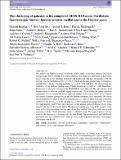The clustering of galaxies in the completed SDSS-III Baryon Oscillation Spectroscopic Survey : baryon acoustic oscillations in the Fourier space
Abstract
We analyse the baryon acoustic oscillation (BAO) signal of the final Baryon Oscillation Spectroscopic Survey (BOSS) data release (DR12). Our analysis is performed in the Fourier space, using the power spectrum monopole and quadrupole. The data set includes 1198 006 galaxies over the redshift range 0.2 < z < 0.75. We divide this data set into three (overlapping) redshift bins with the effective redshifts zeff = 0.38, 0.51 and 0.61. We demonstrate the reliability of our analysis pipeline using N-body simulations as well as ∼1000 MultiDark-Patchy mock catalogues that mimic the BOSS-DR12 target selection. We apply density field reconstruction to enhance the BAO signal-to-noise ratio. By including the power spectrum quadrupole we can separate the line of sight and angular modes, which allows us to constrain the angular diameter distance DA(z) and the Hubble parameter H(z) separately. We obtain two independent 1.6 and 1.5 per cent constraints on DA(z) and 2.9 and 2.3 per cent constraints on H(z) for the low (zeff = 0.38) and high (zeff = 0.61) redshift bin, respectively. We obtain two independent 1 and 0.9 per cent constraints on the angular averaged distance DV(z), when ignoring the Alcock–Paczynski effect. The detection significance of the BAO signal is of the order of 8σ (post-reconstruction) for each of the three redshift bins. Our results are in good agreement with the Planck prediction within Λ cold dark matter. This paper is part of a set that analyses the final galaxy clustering data set from BOSS. The measurements and likelihoods presented here are combined with others in Alam et al. to produce the final cosmological constraints from BOSS.
Citation
Beutler , F , Seo , H-J , Ross , A J , McDonald , P , Saito , S , Bolton , A S , Brownstein , J R , Chuang , C-H , Cuesta , A J , Eisenstein , D J , Font-Ribera , A , Grieb , J N , Hand , N , Kitaura , F-S , Modi , C , Nichol , R C , Percival , W J , Prada , F , Rodriguez-Torres , S , Roe , N A , Ross , N P , Salazar-Albornoz , S , Sánchez , A G , Schneider , D P , Slosar , A , Tinker , J , Tojeiro , R , Vargas-Magaña , M & Vazquez , J A 2017 , ' The clustering of galaxies in the completed SDSS-III Baryon Oscillation Spectroscopic Survey : baryon acoustic oscillations in the Fourier space ' , Monthly Notices of the Royal Astronomical Society , vol. 464 , no. 3 , pp. 3409-3430 . https://doi.org/10.1093/mnras/stw2373
Publication
Monthly Notices of the Royal Astronomical Society
Status
Peer reviewed
ISSN
0035-8711Type
Journal article
Collections
Items in the St Andrews Research Repository are protected by copyright, with all rights reserved, unless otherwise indicated.

